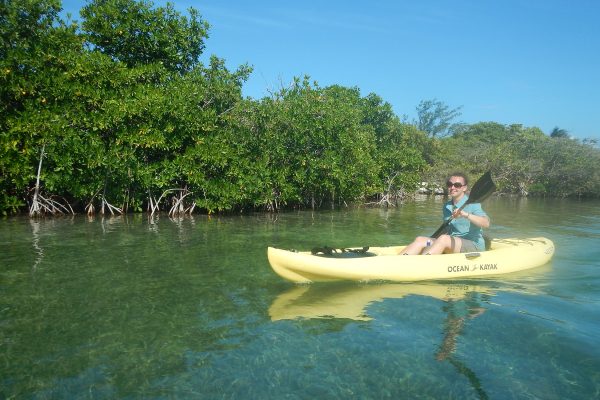Trip duration: 1 week | Approx cost: 500 | When: April – Oct
Doinit factor: The landscapes is amazing!
Everyone’s heard of the Canary Islands, but run your finger North West across the map and you will notice another archipelago in the middle of the vast Atlantic Ocean. These are the Azores; nine islands over a thousand miles away from anywhere else, an autonomous region of Portugal and a real hidden gem. These ‘secret islands’ have been described as Europe’s Eden; and I have only a week to discover if this reputation is just.
Visiting the Azores isn’t particularly difficult. In most cases you’ll just need to travel via mainland Portugal (Lisbon or Porto) where you can get the two hour connecting flight. However, recently Ryanair has started flying direct from the UK meaning that potentially these laid back islands are about to get discovered by a load more tourists. In fact, Portugal has sussed the huge potential for tourism… (money) here and has been investing significantly in the islands airports.
With nine islands I know there’s no way I’m going to see them all in a week but I’ve come up with an itinerary which will take me to three islands and my whistle-stop tour of the Azores. My wife and I will be landing on the main island of Sao Miguel, flying across to Pico before sailing over to Faial
Landing on Sao Miguel
Day 1
Like most visitors we arrive in Ponta Delgada on the island of Sao Miguel. PD is the administrative capital for the Azores and is the main hub from which you can visit the other islands. As the largest of the islands it makes sense to spend more time here. Getting around without a car is not easy so we’ve arranged to hire one at the airport. There won’t be any exploring today, just checking into tour apartment and picking up some supplies from the local supermarket. We’ve based ourselves in Ribeira Grande due to its central location on the island.
Volcanic springs, meat stew, botanical gardens and lots of tea
Day 2
It’s our first morning, and it’s raining so we decided to head to the town of Furnas to see the ‘Caldeiras’ – hot springs, geysers and hot mud pools. The area is in stark contrast to the green surrounding landscape. Water bubbles out of the grey rocks and the thick smell of sulphur fills ones lungs. Visitors walk over an elevated path for safety. By coincidence we’ve arrived just before lunch so we witness local restaurateurs dig up their large clay pots. These pots are filled with ‘Cozidos des Frunas’, a traditional meat stew which is buried in the hot ground to cook in the mornings. Around noon it’s taken out and driven to local eateries. It’s not long before we’re sampling this stew for ourselves. It’s got everything, chicken, potatoes, pork, beef, black pudding and some bits I can’t quite place my finger on. The portions are hearty and it’s a struggle to finish our plates; we pretty much roll out.

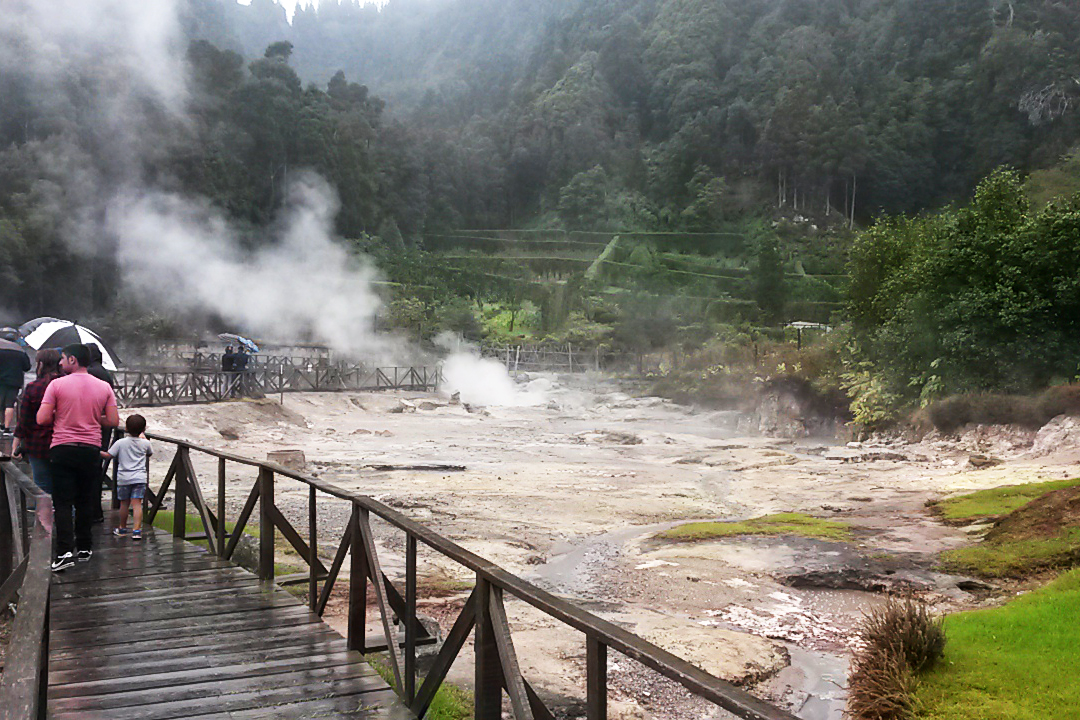
Above: The Caldeiras hot springs on a rainy day | Digging up pot with meat stew heated in the hot ground
Close by are the Terra Nostra Botanical Gardens which provide a good chance to try and walk lunch off. The gardens are truly wonderful, the thick lush green vegetation, huge ferns, tall trees, water lilies and giant plants really can make one feel like they are walking through Jurassic Park. As the wind blows through the gardens, different smells run up my nostrils. I have no idea what Tea Tree looks like but as I can smell it I know it’s somewhere close. The gardens also have hot pools where visitors can take a soak so I’d recommend a visit even if you don’t have to walk lunch off.
Late afternoon provides an opportunity to make a quick stop at Europe’s oldest and only tea plantation (Cha Gorreana), it’s a chance for a free cuppa and take a wander around. There’s no entrance fee, or supervision and I almost feel like perhaps we shouldn’t be here. Around the building you can walk along the rows of hedges of tea.


Above: Terra Nostra Botanical Gardens | Europe’s oldest and only tea plantation, Cha Gorreana
Iconic views, hot seas and pineapples
Day 3
The weather has picked up, the sun is shining. It’s a perfect day to visit one of the Azores most iconic sites; the Miradouro da Boca do Inferno (Hellmouth Viewpoint). It is located on the western part of the island and takes about an hour to drive with a few stops along scenic sites en route. We find a layby and walk about 20 minutes through a wood before it starts to open up and we find ourselves on a natural ridge about 1,000 meters above sea level leading to a stunning view point. Far below are the lakes of Caldeira das Sete Cidades surrounded by steep green crater walls, set to the backdrop of the ocean. It truly is a view one can admire for quite some time but a rumbling tummy signals that it’s time for lunch and to head back to our car.
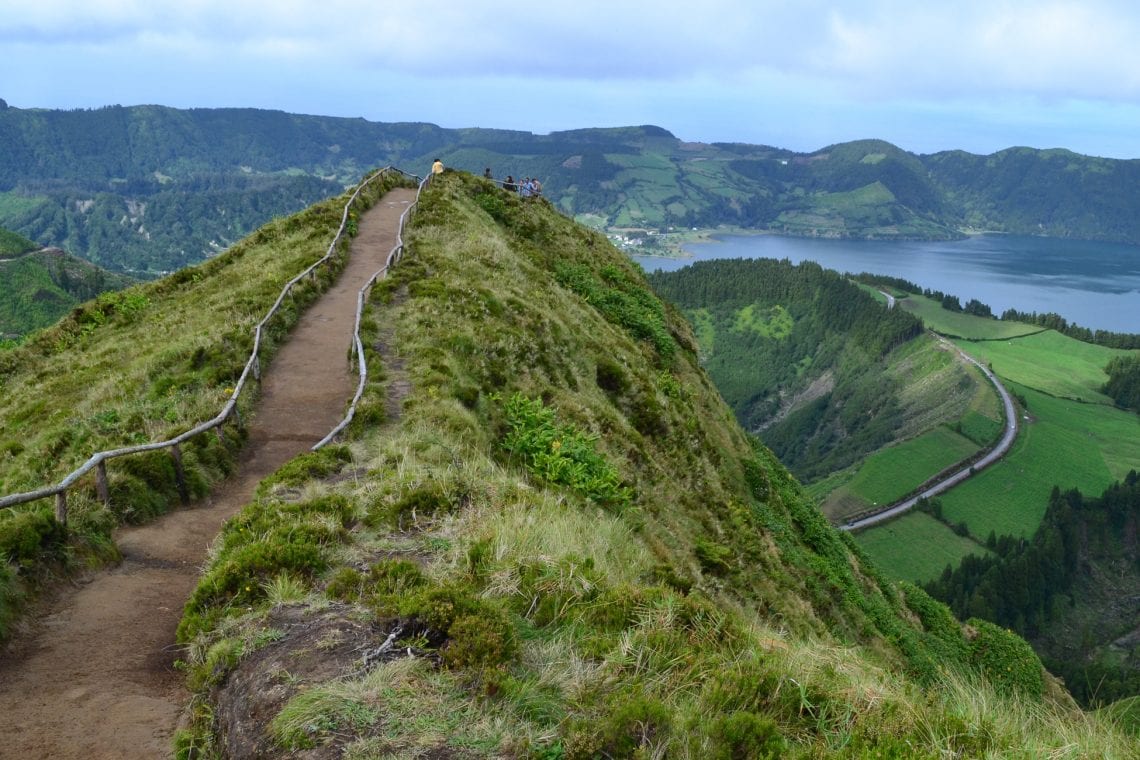

Above: Hellmouth Viewpoint’ – the standard post card view of the Azores about 1,000 meters above sea level
Mosteiros is on the northwest tip of the island and an ideal tranquil area to grab some lunch. It’s surrounded by cliffs, except for the coastline where the Atlantic waves beat the dark rocky shore. I’ve heard a popular past time is to sit and watch the sunset but alas we’re too early for that. Still, with the fresh ocean wind blowing on my face, it’s lovely to take some time and just stare, no matter the time of the day.
From Mosteiros we drive 20 minutes further down the coast, up and then back down again, steep and windy roads which lead us to Ferraria. The volcanic nature of these islands means theres plenty of hot springs, but at Farraria they are underwater; resulting in a heated sea. A natural rock pool provides shelter from the otherwise unsettled ocean. Large crowds are bathing, rhythmically moving along the crest of the incoming waves, it’s clearly one of the more popular places on the island.
The final stop for the day is the Arruda Pineapple Plantation. There’s no entrance fee once again and visitors are free to wander the grounds which consist of large greenhouse where these pineapples grow. I must admit I’ve never really thought about how pineapples are grown, always assuming they hang from palm trees like coconuts but to my surprise they come from the ground. Just like Azorean tea we’re told this is the only place in Europe where pineapples are grown. It’s worth noting that the Azorean pineapple is different than the ones you’ll find in our supermarkets back home. They’re much smaller, richer and juicer; they also found on most menu’s and go incredibly well with a piece of steak or black pudding.
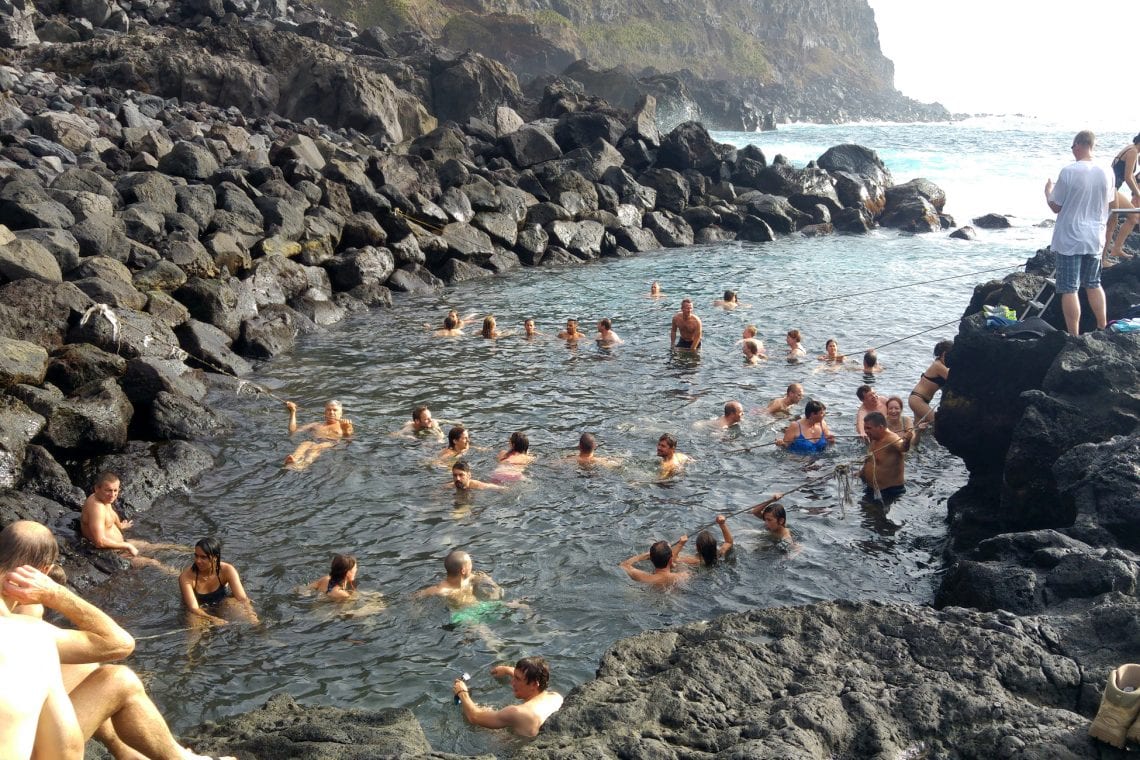
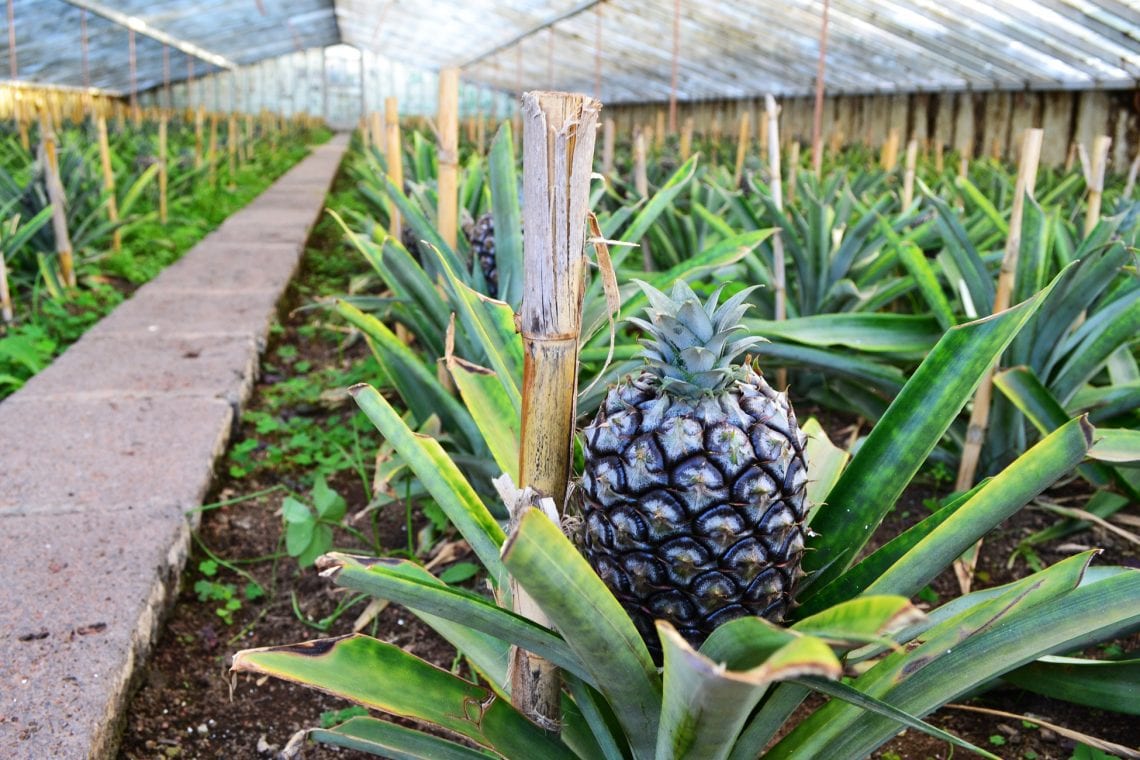
Above: Mosteiros is on the northwest tip of the island | How springs under the sea heating up this natural rock pool | These small pineapples are the best i’ve ever had
Whale watching, more hot water and stunning view points.
Day 4
It’s an early morning but we’ve arranged a whale watching tour so we’re at the harbour at Ponta Delgada for about 8am. The deep waters around the Azores are rich in marine life and popular with many whale and dolphin species with the sperm whale being the highlight of any boat trip. We’re given a short briefing before heading on to the small Zodiac boat. It’s a small group of 10 people plus a marine expert and a driver. The boats motor roars to life as we leave the confines of the harbour and head out into the open ocean. The driver stays in contact with the mainland who radio’s directions to possible whale sightings; the same technique used in times when hunting whales was big business. It’s not long before we see a pod of common dolphins which swim below and tease us with their presence. Not long later we see another large pod of bottlenose dolphins which swim along the boat. Our marine expert then tells us a sperm whale has been spotted so the boat turns around and charges the oncoming waves. Fifthteen minutes of violent crashing down on the sea before the boat slows and we catch sight of a sperm whale. Just as we arrive we see it lift its tail and make its dive down. Glad we manged to see one of these ocean giants even if it was only for a brief moment – it’s time to head back to land. It’s been a fun three hours but I’m glad to be on dry land.
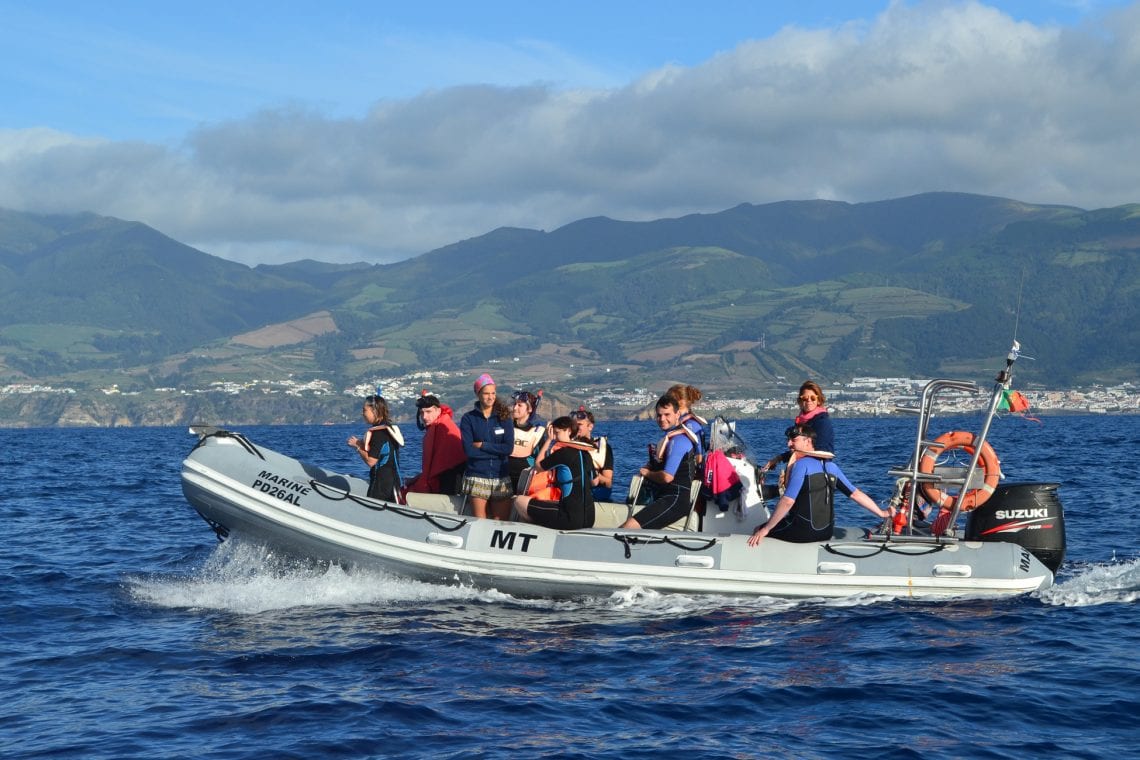

Above: Zodiac boat take small groups on whale watching tours | We didn’t see many whales but there were lots of dolphins
Almost bang in the centre of the island is Caldeira Velha, a waterfall with a pool nestled in the side of a volcano. It’s absolutely stunning, surrounded by thick lush forest and water cascading down the rocks as if a scene from a movie. We are lucky, this is one of the most popular sights on the island but today there’s hardly a sole about so we have this all to ourselves as we immerse ourselves in the warm water and soak up our tranquil surroundings. I’m also rather astonished that the entrance fee is only four euros!
I lost track how long we’ve spent in this magical place but once fully clothed we’re back in the car heading a little further up the volcano to one of the highest points on the island, Pico da Barrosa. The weather here is turning for the worse but we’re still fortunate to see the magnificent Lagoa do Fogo which translates to lake of fire. It’s another crater lake with dark green walls containing a large body of water with no trace of human influence and perhaps, to me at least it’s even more spectacular then Caldeira das Sete Cidades.
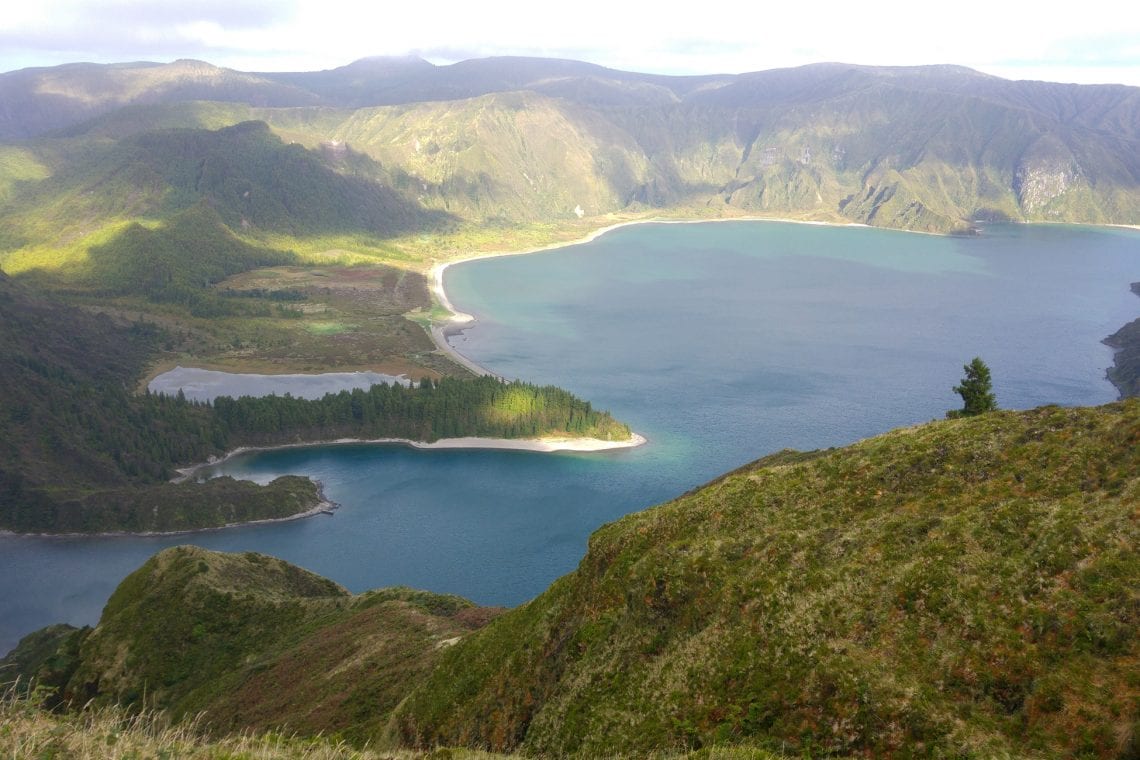

Above: Overlooking Lagoa do Fogo | Taking a dip in warm water cascading down the forest
Flying from Sao Miguel to Pico
Day 5
Pico is a short 50 minute flight from Sao Miguel. As our plane starts to make its descent we see the islands volcano piercing through the clouds, and that’s one of reasons I wanted to include Pico in my itinerary. Pico is home to Portugal highest peak, Mount Pico; a stratovolcano reaching 2,351 meters above sea level. We’ve arranged to climb it the next day, camping at the summit overnight.
The airport at Pico is perhaps the smallest airport I’ve ever landed at. As it’s an internal flight, no passport control is necessary and we’ve grabbed our bags from the only conveyer belt and walk out of the airport within minutes. I was expecting a row of taxis parked outside but instead it’s deserted and I can’t help but have a slight giggle when the only thing I hear is a lonely cricket greet. A passer by tells us a taxi will be around shortly to take us to the main town of Madalena.
It’s a small town with a quaint little harbour, but it’s lovely to just sit in one of the bars overlooking the sea. By now the earlier clouds have dissipated revealing the humongous volcano backdrop as we sip on our ice cold beer.
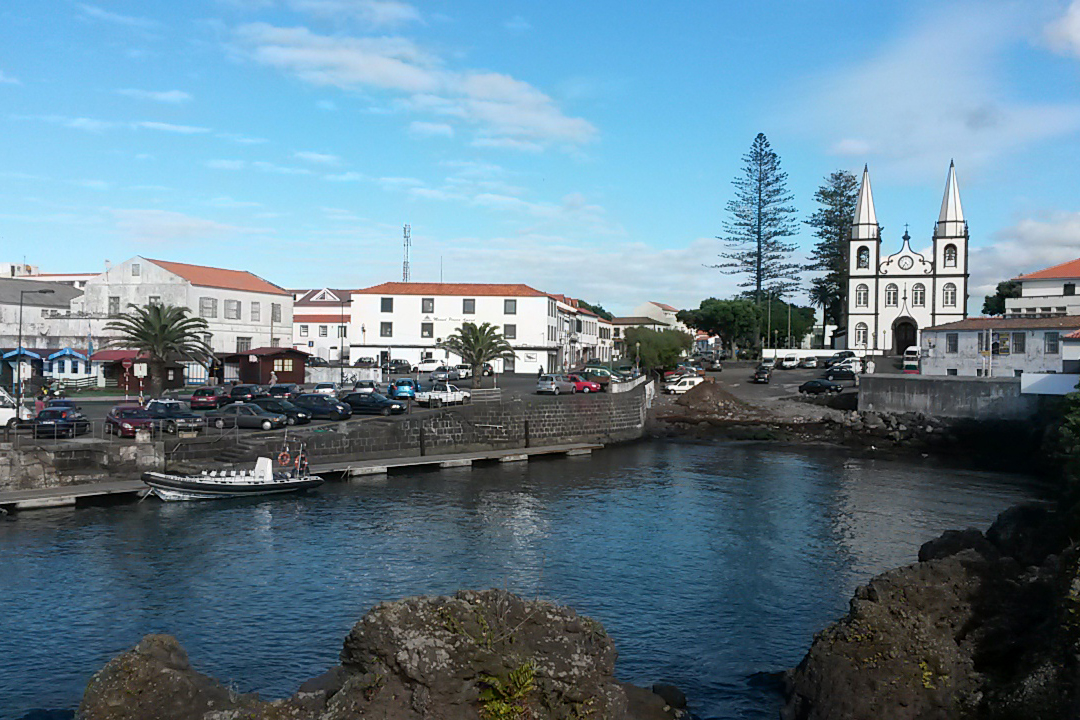

Above: Flying to Pico | Sipping on a cold beer over the harbour in Madalena |A rare moment when Mt Pico was not hidden by clouds
Summit attempt abandoned, short hike through ancient vineyards
Day 6
The weather has turned. It’s been lashing it down all morning and I’ve had word from our guide the summit attempt is off. I’m left feeling gutted; Mount Pico is completely hidden behind a grey wall of cloud. It’s time for a plan B.There is more to the island than its giant peak. ‘The landscape of the Pico Vineyard Culture’ is a UNESCO world heritage site. There are miles of these vineyards which are protected from the salty ocean winds by basalt walls, some dating back to the 15th century. While the weather is still pretty bad we decide it is still worth going on a short hike through these vineyards. I try to perceiver through the rain and wind but after a few hours I’ve had enough and I turn to the Mrs to suggest we call it a day and head back. While I’ve been disappointed that we’ve not managed to climb Mount Pico, I certainly appreciate why. It’s not been a pleasant day at sea level but no doubt it would have been so much worse at 2,000 meters.

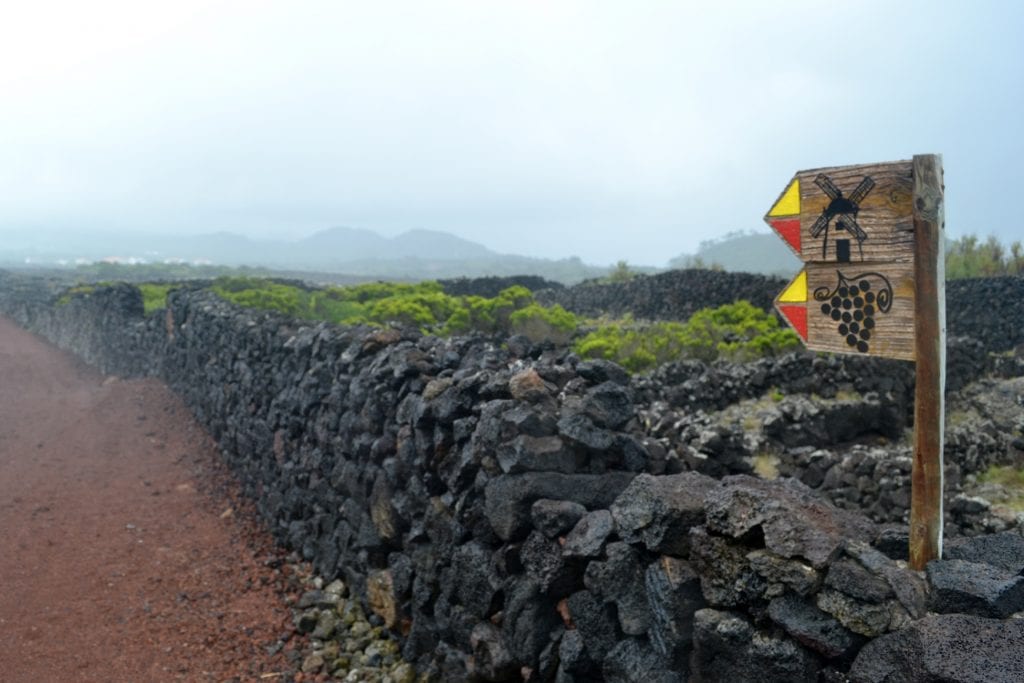
Above: Hiking along the UNESCO vineyards | Pico in the background completely hidden within the clouds
Sailing from Pico to Horta
Day 6
It’s our final day on our travels. Tomorrow we fly back to the UK via Lisbon. However our flight is from the neighbouring island of Faial, also called Horta, after the main settlement. There are daily ferries but we’ve arranged for a yacht to pick us up and sail us over. The yacht will also double up as our accommodation for the night once we moor up in the harbour.
The yacht bops up and down as we make our voyage through the unsettled ocean between the islands. Hugo our skipper instructs his crew to drop the sails and they catch the wind. He then turns to me and asks if I want to take the helm – I sure do. Steering the yacht to the harbour is fun but as the waves break on the hull there are times it’s tricky to keep the boat sailing in the right direction. We make it safe and sound. The harbour wall and pier are covered in mural painted by visiting yachts. Horta has a long history as a stopover during trans-Atlantic crossings. The town itself has a real charm about it and it’s certainly livelier than many of the other towns we passed through.
Hugo takes us to the back end of town for a beer, overlooking a picturesque bay. After a few suggestions of places to eat we make our own way bar crawling back to the marina and finishing in the famous Peter’s café for some live music. It is considered, thanks to some good marketing as a historical and cultural landmark but in short it’s been a popular joint for countless yachtsman over the past 80 odd years, even being voted as the world’s best bar in 1986 by Newsweek magazine.
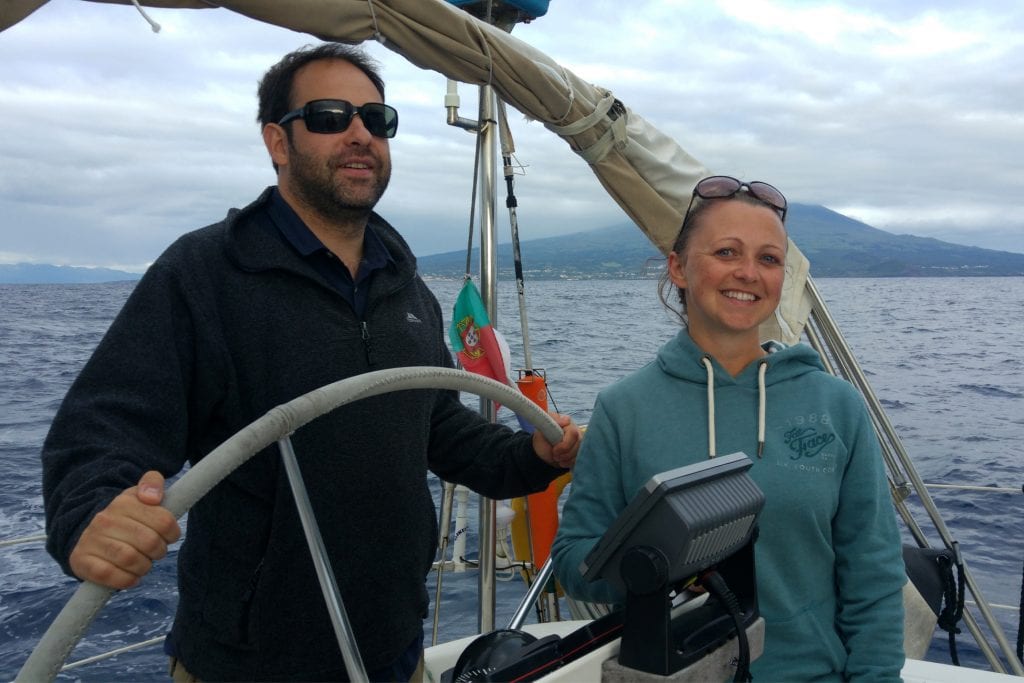
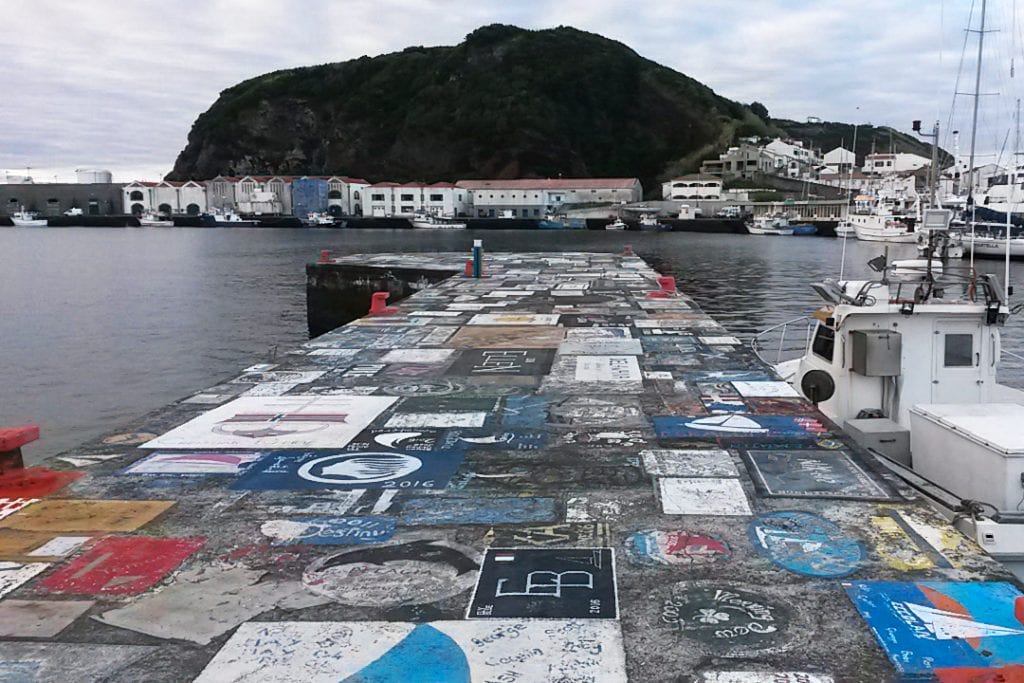
Above: Sailing from Pico to Horta | Murals left by crews during their trans-Atlantic voyages
Hometime
Day 8
After a night on our boat it’s an early morning as we leave these wonderful islands. I’ll be sad to leave. Despite not having the ideal weather we’ve certainly feel like we packed in a lot during our stay, seldom allowing the rain to hinder our plans.

Above: Boarding our flight home (via Lisbon) with Pico in the distance
WHERE TO STAY
There is good choice across the archipelago. We opted for private apartments.
USEFUL LINKS
- If you want to climb Pico check out: www.tripixazores.com
- A great read if planning a trip to the Azores is: triptins.com/5-day-sao-miguel-azores-itinerary
- You’ll like need a stop over in Lisbon or Porto. Read our story here




